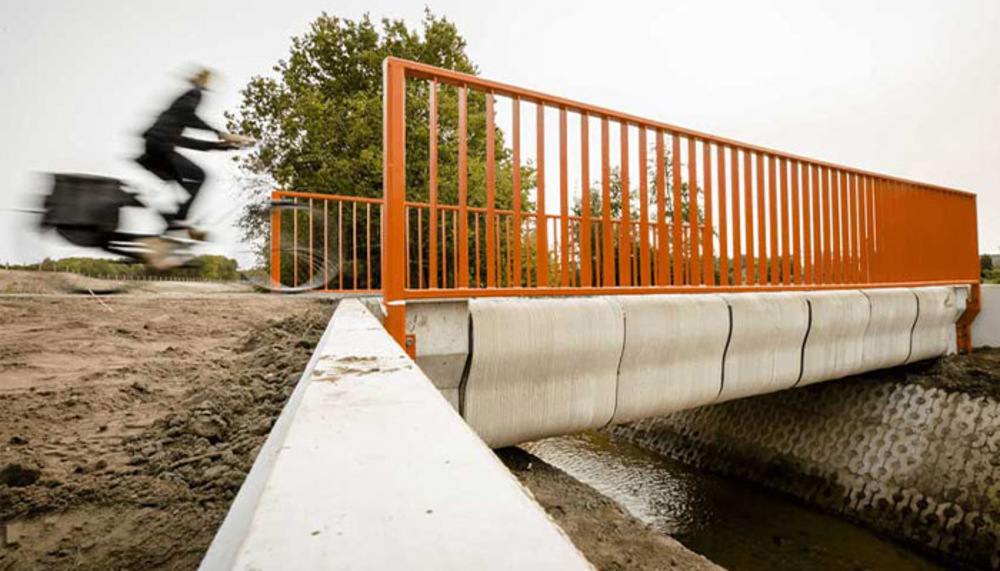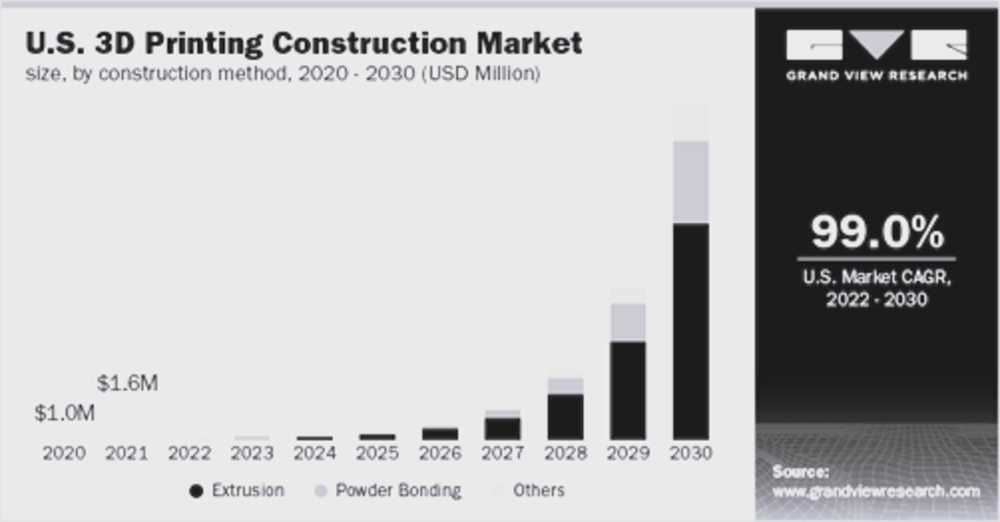This article is part of a blog series in which covers how 3D printing is used on construction sites, such as replacing broken parts on construction equipment or even building new houses. We have all heard the buzz around 3D printing in the last ten years but is it merited?
The infrastructure segment in the construction industry is expected to register the fastest market growth rate in the near future. The increasing use of 3D printing to construct infrastructure such as bridges, using materials such as metals, plastic, and composite, is driving the segment's growth.

3D printed bridge in the Netherlands
Various initiatives undertaken by key companies across the world to build 3D-printed bridges are growing.
For instance, the first largest and longest concrete 3D-printed bridge in the world was 29 meters long and was opened on September 8th, 2019.
The architect, Michiel van der Kley, made a creative design, following the instructions of the municipality of Nijmegen. It was printed in the Saint Gobain Weber Beamix concrete printing factory. Bureau Witteveen+Bos had the responsibility for the parametric model’s construction and Summum Engineering was the technical engineer. It was built by the BAM construction group.
Bas Huysmans, CEO of Saint Gobain Weber Benelux said:
This 3D production technique delivers savings of up to 50 percent in materials because the printer only deposits concrete where it is needed for structural strength. 3D technology is maturing and is becoming a serious option for faster, more sustainable, and cheaper construction of bicycle and pedestrian bridges.
Theo Salet, Professor of Concrete Structures at TU Eindhoven said
The printing of concrete has enormous growth potential. We use less raw materials and can drastically increase the construction speed. In the future, we want to make concrete more sustainable and also reuse it. There is much more to achieve. I am also proud that the knowledge developed has quickly found its way to the industry.

3D printed house model
3D printing in construction has real enduring potential and cannot be ignored.
It is difficult to imagine that one day it will be the only technology used in construction, but it will certainly become a state-of-the-art solution that will bring a lot of benefits. It offers cost savings and is eco-friendly for the future of construction.

New solutions will be discovered thanks to 3D printing, but they will also meet challenges due to the very nature of the construction industry.
New possibilities are constantly developed by architects around the world, using the latest 3D-printed prototype. So, we can be sure that the future is here to stay.
For instance, outside Austin, Texas, USA, 100 three- and four-bedroom homes, are being built it is the first large housing development to be 3D-printed on-site. Lennar, a home builder, is partnering with ICON, a 3D printing company, to develop the project.
The project reached a third of its completion. More than 80 of the home sites are in various stages of construction. Rune, the first model home, is now open to visitors.
Stuart Miller, executive chairman of Lennar said:
This is the first 100 homes, but we expect to be able to bring this to scale, and at a scale we really bring cycle times down and we also bring the cost down.
ICON claims it can build the entire wall system of the home, two to three times faster than a traditional home, and at up to 30% of the cost, the wall system includes mechanical, electrical, and plumbing.
Around the world, partnerships are forming to automate the construction of homes, offices, and other structures through techniques like 3D printing, robotic finishing, and automated bricklaying.
Governments and investors increase their support to help the automation of the construction industry. This mitigates the risks of low efficiency due to waste, sustainability, and labor shortage, the main causes of the slow construction of new houses which alarmingly increases house prices towards unaffordability.
Eric Holt, assistant professor at the Franklin L. Burns School of Real Estate and Construction Management at the University of Denver said that the ball has moved quickly.
Mighty Building completed accessory dwelling units (ADUs) called Mighty Mods in Oakland, San Diego, San Ramon, and Hayward, California, employing a combination of high-tech composites, 3D printing, 3D scanning, and robotic finishing. The company is now building 3-bedroom houses priced between $290,000 and $410,000 and hopes to join forces with developers to create multifamily housing communities and more.
Engineers at Arup used 3D printing to fabricate a steel node for a lightweight structure reducing costs, cutting waste, and enabling a very sophisticated design.
Professor Behrokh Khoshnevis at the University of California has developed a process to build the walls of a house in 24 hours.
Shanghai firm WinSun Decoration Design Engineering has used large 3D printers to spray a mixture of quick-drying cement and recycled raw materials to construct 10 small demonstration 'houses' in less than 24 hours.
Spain saw the first 3D-printed pedestrian bridge in the world (3DBRIDGE). It was inaugurated on 14 December 2016 in the urban park of Castilla-La Mancha in Alcobendas, Madrid. The bridge has a total length of 12m and a width of 1.75m and is printed in micro-reinforced concrete.
An alternative approach to 3D printing for the fabrication of buildings is presently in development and is called the 2D 'WikiHouse' project. WikiHouse is not an additive process, but an open-source set of construction data for building components you download to manufacture and assemble locally, frequently used materials and equipment. This is low-tech prefabrication that requires little training. Using SketchUp, you can develop pointed extracts for components to manufacture a standard piece of materials using a CNC (computer numerical control) machine. The subsequent frames can be constructed and amassed by hand, the cladding panels are attached and services and windows connected. With this method, you can build a single-story house frame in one day.

You would probably agree that the above projects have a lot of potential to construct better, faster, more environmentally friendly, and lower-cost infrastructure or buildings.
In various parts of the world, systemization in construction is not widely utilized, and when in use, for example, in panelized systems for high-rise apartment blocks in the United Kingdom, they can be boring and ugly, often with problems such as condensation. We have seen a worldwide revitalization of modularization and prefabrication, but the market share is still low.
All of these innovations are capital-intensive as they require complex types of equipment. Technology is evolving so rapidly that we can envisage that less sophisticated equipment will be developed, and their prices will be lowered, as they will be utilized on an industrial scale.
But will it replace more conventional methods of construction? We'll leave that to the market to decide.

A reusable construction product based on waste sawdust has been developed by researchers in the US as an alternative to concrete.
The University of Michigan’s BioMatters team developed the material. It is 3D printed to create the required form which is:
BioMatters (DART) Laboratory has processed the sawdust to make it the base for their new product solution.
Their approach couples robotic 3D printing of the wood-based material, with concrete casting, to create zero-waste free-form concrete structures.

As per the Grand View Research Report the 3D construction market is planned to grow rapidly up to 2030.
The world has a severe shortage of housing.
The White House says the U.S. currently has a housing shortage of about 4 million homes. Houses just can't be built fast enough. China, Europe, and the United Kingdom are also demanding faster, more efficient, and less wasteful construction. 3D printing is no longer restricted to components, we are now printing entire buildings. This is part of the solution to the problem.
Giant 3D printers could make a difference and they have now built the first 3D-printed homes in the U.S.
Throughout the world, big steps in 3D bridge printing have changed the industry within the last five years. These designs use fewer materials to reduce environmental impact. Surely these earliest 3D-printed bridges will continue to inspire future development as the 3D printing industry grows.
3D printing is a more sustainable approach than traditional construction. The use of concrete is still quite a carbon-intensive process.
Companies should include additive manufacturing processes to improve construction automation such as bricklaying and others.
Driving Vision's technology appraisal looks at the best way to insert new technology in your workflows and how to move your organization to cloud computing so you can open new possibilities for your daily planning tasks and make sure your data never leaves the optimally secured data center.
A Driving Vision expert will conduct the interviews online and will discuss with you the report and, our findings. Together we will decide the best way to implement the solutions, at your pace and according to your budget
Implementing BIM can be daunting, but Driving Vision is here to help you at the pace you are comfortable with. Get started by getting in touch now
You minimise the level of investment required to implement BIM as we share the Research and Development costs with other client
You increase your revenue by staying ahead of the competition as BIM best practices allows you to win bigger and more rewarding projects.
You reduce your costs, more than our fees cost you, by decreasing potential litigations, rework, and errors and omissions
